-
Posts
936 -
Joined
-
Last visited
Content Type
Events
Forums
Downloads
Quizzes
Gallery
Blogs
Posts posted by 007 RED
-
-
17 hours ago, motdaeng said:
based on your data, a 2.32 kw peak system generates an average of 11.94 kw per day, which seems too high and not very realistic to me ... (i would say is more about 8-9 kw/day)
your calculation assumes that every watt produced is fully used, which is quite unlikely – unless you're running a few air conditioners 24/7 ... (but in that case, the system would probably be undersized anyway).
maybe some other forum members with DIY setups can share their real-world ROI numbers ... i think if someone can do it an ROI in about 5 yeas, that would be nice ... (but not 15 months or less) ...
Yep, its possible but dependent upon how much solar you install, and if using an ESS, or not.
I installed a small scale grid tied system during the Covid era, and it paid for itself in 2.25 years. I subsequently added a couple more panels so that I could run the system without feeding back to the grid and on average the system provides us with 75% of our electrical needs. Our PEA bills are about 200 THB/month. which accounts for our night time use.
-
 2
2
-
-
Not me this time, but a warning about ensuring that your carport (or roof) can take the weight of your solar system.
OUCH !!!!!!
-
 1
1
-
 1
1
-
-
- Popular Post
I bet that someone will be wishing that they had purchased F16s now instead of Saab Gripens. In fact, had they opted for the F18 they may have been eligible for a rebate

-
 2
2
-
 1
1
-
 12
12
-
46 minutes ago, Crossy said:
Yes, you need a second CT.
Yes, they can sit next to one another without interference. We were running like this (with the CTs less than an inch apart on the cable) for some months and everything worked just fine.
Based upon Crossy's Theorem™ which states "You can never have too much solar", and assuming space and budget allow, I'd go for 6 panels and a 3kW inverter. You will start generating earlier and keep generating later.
Thanks... I thought that would be the answer. Not a problem.
As much as l would like to have more panels, the space on the washroom roof will only allow 4 panels. I might up the size though.
-
- Popular Post
-
Current System:
Sofar 3kW grid tied inverter connected in series to 6 x 415W panels which are facing South on the carport roof.
Historical daily use is approximately 10 units per day, comprising 7 units during the day and 3 units at night.
System provides 85% (plus) of our electricity needs during the day when in export mode, and approximately 40% during the day when in no export mode.
The system logs clearly indicate that we tend to use most units during the early part of the morning particularly when my better half does the washing (or at least the machine does).
Proposal:
Add a second system comprising a 2kW grid tied inverter connected in series to 4 x 415W solar panels which will be mounted on top of the washing room roof which faces East and gets good sunlight during the early part of the morning. Both inverters will be located quite some distance apart from each other.
My hope is to have the two GTI systems, both constantly in no export mode (so that the meter never runs backwards), and provides sufficient power to meet our daytime needs, particularly during the early part of the morning when the washing machine is working.
Questions:
The existing GTI is connected to a CT which is located on the incoming Live supply from the pole to the house. A simple on/off light switch connected in series between the CT and the inverter allows me to switch between export and no export modes, as required.
Q1. Do I need a separate CT for the second GTI, or can I connect the existing CT to both inverters?
Q2. If the answer to the above is that I need a separate CT for each GTI, can they be located next to one another, or do they have to be physical separated from each other in order to avoid any undue influence from each other?
-
02 Aug 25 @ 17:00 Just topped up my Elder card at Lak Song. Cashier took my THB and loaded my card. No mention that card is only for Thais or any other restrictions.
-
 1
1
-
 1
1
-
-
I would suggest that for the opening ceremony parade, the women all wear Tuk Tuk costumes (as per the Miss Universe Contest a few years back photo below).

The men could wear motorcycle suits. When the march out, and around the stadium, the TTs and m/c should weave in and around each other, just like they do in BBK traffic.
Now that would be a real display of Thai culture 😊
-
 2
2
-
-
I know it’s been a long time since this topic was discussed.
Did anyone manage to resolve the issue of CT ‘ghosting’ in the No Export mode on their Sofar inverter(s)?
The reason for asking is that it appears that the software in my Sofar 2.2kW inverter has somehow been recently updated – not by me I might add.
I noticed this recently when looking at the LC Display. The initial reading used to indicate “NORMAL” and ‘XXX’ Watts. It now shows “DERATING” and ‘XXX’ Watts.
When in the No Export mode, with the inverter’s Reflux setting (#17) set to zero, the online monitoring facility is showing the CT is now sending power going back towards the grid. It has never done this before to the best of my knowledge.
Most of the time this back feed (in the No Export mode) is 10W which has the effect of almost stopping the disc meter spinning backwards, but not totally. The disc appears index backwards very, very slowly.
However, at times the back feed to the grid is substantial e.g. 60W, as shown in the screen shot from the monitoring graph below (taken today). The disc movement (backwards) is very noticeable, albeit slow. Not something that I want the meter reader, or any other PEA employee, to see.
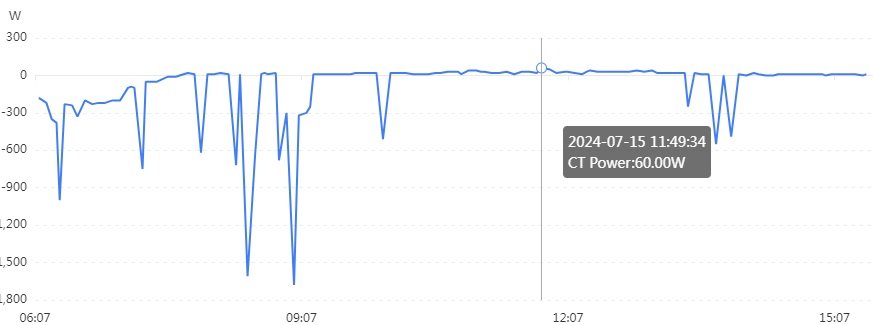
Any advice/assistance would be most welcome.
Regards
007 Retired Extremely Dangerous
-
 1
1
-
-
2 hours ago, CharlesHolzhauer said:
Many thanks for this very useful information. I had no idea that the panels are sensitive to heat - thanks again.
It should be borne in mind that the panel’s rating (e.g. 330W) has been determined under ideal laboratory controlled conditions with a specific light source being directly perpendicular to the panel photocells, and the temperature of the panel being maintained at 25oC.
Unfortunately, ideal conditions rarely exist in the big bad world and the rating figures provided by the panel’s manufacturer may well be much higher than is achievable in a ‘real world’. The losses in the panel's efficiency are attributed to the following factors.
Firstly as you will appreciate the sun is constantly moving throughout the day from East to West, and depending upon the time of the year it may be closer to, or further away from, the Southern horizon at any given time of the day. As a result, it highly unlikely that the sun’s rays will be hitting the photocells within the panel(s) perpendicularly for much time during the day unless your panels are mounted on a very expensive tracking system. As a consequence, the panels will lose some of their potential output efficiency.
Secondly, solar panels can get quite hot from the heat which is radiated from the sun which can make the temperature of the panels raise to as much as 70oC or 80oC. Unfortunately, the hotter the panels become the greater the loss of the panel’s potential efficiency. The panel's manufacturers specification should indicate % loss for each 1oC above the the standard test temperature of 25oC.
FYI..... Below is a reading which I took with a basic handheld electronic thermometer of my panels at mid-day on a good sunny day. Ambient temperature was 32oC Admittedly not totally scientifically accurate, but it makes the point. The panels were certainly far too hot to touch.
Thirdly, reductions in the panel’s efficiency will occur due to shading caused by buildings, trees, clouds/haze or dirt/dust accumulating on the panel and blocking the sun’s rays from reaching the panel’s photocells.
Apparently, it may be reasonably assumed that a system might lose as much as 25% of its efficiency due to a combination of the above mentioned problems.
Hence, assuming that 12 x 330W panels should in theory produce almost 4,000W, in practice (assuming a 25% loss) they are more likely to produce just 3,000W on a sunny day, at mid-day.
Once again, good luck with your proposed project.
-
 1
1
-
-
@CharlesHolzhauer Welcome to the wonderful world of Solar.
When I did my sizing research (approximately 4 years ago) I was not aware of the monitoring devices as suggested by @Bandersnatch above. I used two methods to give a reasonable estimate of much power we were using, namely:-
-
Log into our PEA online account, insert some basic account details found on our bill, and it returns basic information on number of units used per month for the past 12 months. By simply dividing the number of days in each month you will have a reasonable indication on your daily use. As @KunLA has indicated above, your monthly PEA bill also provides basic consumption details for the past 6 months.
- Take a meter reading at approximately 6am, and then another at 6pm. Do this over a month, or longer, if possible. This will give you a reasonable indication of usage during daylight hours and at night. This is particularly useful (night time usage) if you are considering installing a hybrid system with an Electrical Storage System (ESS).
The above methods will give you a reasonable ‘ballpark’ figure of the number of units used which can then be used for sizing your proposed system.
Regarding the number and size of solar panels you will need, please be mindful that the panels can can get very hot as a result of radiated heat from the sun, this can result in the panels loosing as much as 25% of their rated output. For example: 6 x 415W panels in theory should produce approximately 2.4kWh when the sun is directly above the panels, but because of the heat they are more likely to only produce around 1.8kWh. So you may need to factor in more panels to cater for heat loss.
Best of luck with your proposed project.
-
 1
1
-
 1
1
-
Log into our PEA online account, insert some basic account details found on our bill, and it returns basic information on number of units used per month for the past 12 months. By simply dividing the number of days in each month you will have a reasonable indication on your daily use. As @KunLA has indicated above, your monthly PEA bill also provides basic consumption details for the past 6 months.
-
- Popular Post
A few members have in the past commented that there are no real consequences if you get caught for having a grid tied solar system which has not been approved and your system spins the old style meter backwards. If I recall correctly those members advised that at worst the PEA will just change the spinning meter for a new electronic one so that you can’t spin the meter backwards in future and that they never take any action against that solar system owner.
FYI
Not far from my home, there is a multi-lane flyover which crosses a major arterial road out of Bangkok. A couple of years ago, whilst driving over the flyover, I noticed that a town house (on my left) had installed a substantial array of solar panels on the roof. The array is very obvious as you drive over the flyover as you are almost level with the top of the building. See screen shot below from Google Earth.
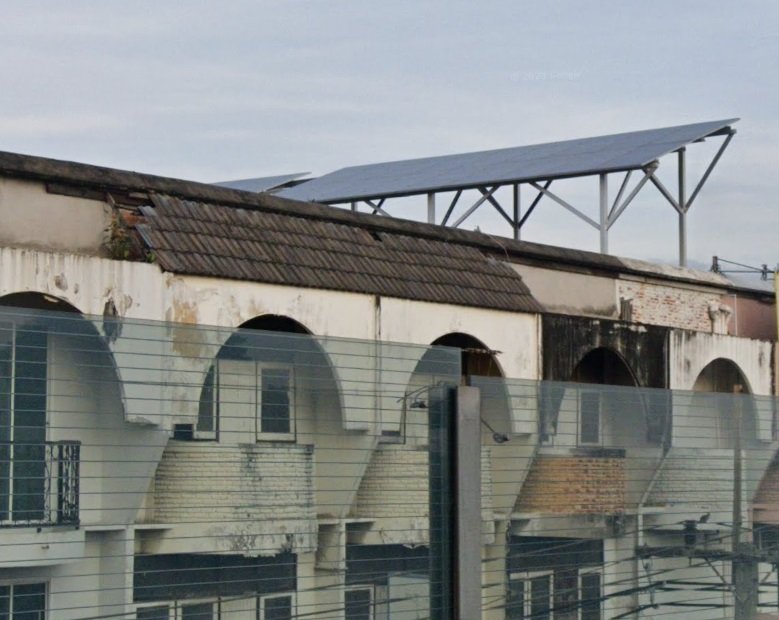
Recently, whilst my better half was driving, I noticed as we passed the solar panels there was something odd about the backside of the panels. See screen shot below from Google Earth.
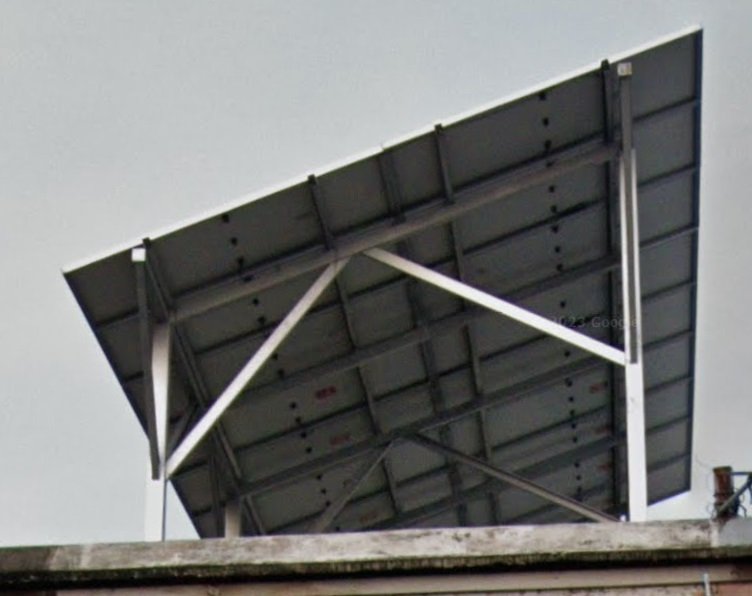
Can you spot that something is wrong? Look closely at the junction boxes on the rear of the panels. There are no cables coming from them.
Being somewhat curious as to why the solar panels didn’t have any connecting cables, I decided to stop at the townhouse over the weekend and asked the owner if he wouldn’t mind enlightening me about his solar system. He was very obliging.
He explained that he had the solar system installed by a local company 3 or 4 years ago to help reduce his electricity bill. He said that he was never made aware that he needed to have the system approved, or the risks of having his meter spinning backwards.
Early last year, the local PEA knocked on the door and advised him that they had observed that his meter was spinning backwards. They advised that his account showed a considerable reduction in his electrical usage during previous years. They also said that they had seen his solar panels on his roof and asked to see his system.
The house owner told me that the PEA officers informed him that if he did not allow them access to inspect the solar system, they would get a Court order and return with the police. He decided to allow them to inspect his system.
The upshot was his grid tied system was illegal (meter spinning backwards and no approval).
The PEA officers gave him a choice, either have the system disconnect or face Court proceedings for theft which could result in a very substantial fine, plus compensation for their loss of income.
The homeowner said the PEA officers advised that if he allowed them to disconnect the system there and then, they would not take any further action against him because he had co-operated.
He said he obviously opted to have the system disconnected. The PEA engineer then cut off all the leads from the back of the solar panels which has rendered the panels useless. They also cut off all the cables to/from the inverter. He also said that a few days later the PEA installed a new electronic meter without any warning.
According to the homeowner, the installations set him back a couple of hundred thousand Baht. He said that he realised that if he had not co-operated with the PEA, it was clear that not only would he have ended up having the system disconnected by a Court Order, but he would also face having to pay a heavy fine plus compensation to the PEA for their loss of income.
In my opinion, I suspect his unfortunate downfall was most likely due to the obvious visibility of his solar array which cannot be missed when driving over the flyover. No doubt a local PEA officer spotted it and started making enquiries.
OUCH!
-
 1
1
-
 3
3
-
- Popular Post
- Popular Post
Just now, glegolo18 said:thank you so much, does 12/7 means he can not enter Thailand...
OP… from the picture that you posted earlier of the Immigration exit stamp in your friend’s passport, it is clear that he/she was removed (deported) from the Kingdom under Section 12.7 of the Immigration Act, as indicated on the 3rd line of the stamp e.g. 12 (
7).As I indicated in my previous post, Section 12 of the Immigration Act gives Immigration the power to refuse entry and revoke permission to stay of if the alien falls into any of the categories specified.
Section 12.7 basically states: -
“Having behaviour which would indicate possible danger to the public or likelihood of being a nuisance or constituting any violence to the peace or safety of the public or to the security of the public or to the security of the nation or being under warrant of arrest by competent officials of foreign governments”.
Your friend apparently fell within the above category having assaulted his girlfriend and subsequently served a custodial sentence for that offence.
Regarding being banned from entering the Kingdom, given the reason for his/her deportation, I would say that a ban from entering the Kingdom is almost 100% certain. The big question being how long is the ban for?
Immigration has what is known as a ‘tariff’, that is to say a maximum length of ban for a given type of crime. My understanding is that in the case of an assault conviction the duration of a ban could be as long as ‘life’. However, the actual length of the ban is left to the discretion of a Senior Immigration Officer (Senior Colonel or above) who authorised his/her deportation.
The problem so far as your friend is concerned is that there is no mention of the length of any ban stamped into his/her passport (there never is). The details of the ban will only be recorded on his paper file(s) and on the Immigration computer system.
If your friend is banned, and he/she tries to enter the Kingdom by air, it is unlikely that the airline will allow him/her to board the plane. This is because all international flight to Thailand are required to send passenger biographical details to Thai Authorities via a system known as Advance Passenger Information System (APIS), one hour before scheduled departure. The system (APIS) is linked to the Thai Immigration database of undesirable persons. If the system detects that your friend’s biographical information matches that on their database, the system automatically sends the airline a “Do Not Board” code. No reason is given to the airline. The airline would be heavily fined if they allowed your friend to fly having received a "Do Not Board" code, plus they would have to pick up the cost of flying him/her back to the departure country. A refusal to allow the person to board the aircraft will mean that the passenger will not be refunded for the loss of the flight (outward and return).
If your friend is banned and was to travel to a neighbouring country and attempt to enter the Kingdom via a boarder land crossing, it is highly likely that the moment the Immigration Officer places the biographical (photo) page onto the desktop scanner, the system will flag a warning on the Officer’s screen. This will result in him/her being denied entry and he/she will be sent back to the country which they just left.
I am given to understand that some lawyers, and agents, reportedly have connections within Immigration, and for a fee will establish if your friend is banned. If it is possible to have a ban overturned, is a matter of speculation.
As has been suggested by several other members, his/her best solution to recovering money in his/her bank account(s) and selling off his/her condominium, would be to give a very trusted friend Power Of Attorney to act on his/her behalf to deal with the bank and sale of the condominium.
-
 1
1
-
 1
1
-
 8
8
-
- Popular Post
- Popular Post
26 minutes ago, glegolo18 said:I just spoke to the guy, he didn´t get any stamps whatsoever in Thailand when he was deported....
What can we think about that????
Sorry, but your friend would most definitely have had an immigration stamp placed in his passport indicating that he had been deported from the Kingdom. It would be red, rectangular and take up almost half a page of his/her passport. The stamp would be in Thai and provide details under which section of the Immigration Act he/she was deplored. The deportation stamp will not indicate if he/she has been banned from entering the Kingdom.
I suspect, given the information that you provided in your original post, he/she would have used Section 12.7 which basically states:-
"Having behaviour which would indicated possible danger to the public or likelihood of being a nuisance or constituting any violence to the peace or safety of the public or to the security of the public or to the security of the nation , or being under warrant of arrest by competent officials of foreign governments".
With regards to the question whether or not your friend is banned from entering the Kingdom, I would say that there is a very high probability that he/she is on a list of 'undesirable' persons. Again if he/she attempts to enter the Kingdom the Immigration Officer will most likely refuse entry based upon Section 12.11 which basically states:-
"Being deported by either the Government of Thailand that of or other foreign countries ; or the right of stay in the Kingdom or in foreign countries having been revoked ; or having been sent out of the Kingdom by competent officials at the expense of the Government of Thailand unless the Minister shall consider exemption on an individual special case basis".
The Immigration Officer can also refuse entry as per Section 12.7, as indicated above, given your friends past history.
FYI... It is often suggested that persons' in similar situations to your friend should get a new passport, and if possible change their name. Sorry but the immigrations systems used throughout the world (including that used by Thai Immigration) are more than capable of matching up previous/current passports.
-
 4
4
-
 2
2
-
 1
1
-
1 hour ago, Crossy said:
@007 RED how are you doing on the recovery front?
I went to the hospital last week for a follow up check up. Must have had about 20 x-rays on my ankle and chest. God, its a wonder that I'm not glowing in the dark. Saying that, maybe a new topic - Alternative Energy = Nuclear Power

Thankfully the ankle is on the mend. They've taken the cast off and given me a 'Beckham Boot' as shown below. The joy is that I can take it off to have a shower, and also at night to sleep, but I must wear it whenever I need to put weight on that leg.
The consultant said that I need to keep wearing the boot for at least another month until the ankle bones have fully knitted. He advised that if they become displaced, I will likely need surgery to have metal plates and screws inserted to hold the bones in place. More expense that I will definitely try and avoid.
The collapsed lung appears to be functioning OK now and my blood oxygen saturation levels are almost back to normal levels.
The fractured ribs are still giving me a lot of grief. The Doc said that given my age (77) they may well take several months to heal because they are continuously flexing every time I breath in/out. In the mean time its a case of popping the meds to keep the 'discomfort' under control.
I'm still uncertain as to exactly what happened. All I can recall was that having made sure all the cables were tucked well under the solar panels, I was making my way back to the ladder to come down when my foot slipped. The next thing that I remember was laying on the carport floor, unable to move, feeling totally numb and having difficulty breathing. My better half, who was in the house, heard the crash and ran out to the carport to see what had happened and phoned for the ambulance. The next thing I remember was being strapped onto a backboard and transported to hospital. The rest is history.
I just thank my lucky stars that I didn't land head first. From that height the outcome would most likely have been fatal. A sobering safety lesson learned and I'm extremely grateful to my wonderful wife for taking so much care of me.
On 3/7/2024 at 5:22 PM, Lacessit said:IMO the ladies like an ATM which is open all hours.
I like to think that my better half doesn't think of me as being a 24 x 7 ATM

-
 1
1
-
 1
1
-
-
On 3/7/2024 at 11:16 AM, Crossy said:On 3/7/2024 at 11:54 AM, 007 RED said:
Yes... Local handyman did the repair for a couple of beers. No way could l do it with a cast on my leg. Apart from that, my better half has banned me from going up there until l get a walkway put up there.
I've just discovered that the local handyman who repaired the 'ventilation hole' in the carport roof appears to have spilt some silicon sealant onto the glass of 2 of the solar panels.
I assume that he had to remove the mounting screws which hold the panel bridge mounts in order to fit the replacement cement tiles and was using the silicon under the 'feet' of the solar panel mounting bridges to prevent water ingress under the feet.
I've not been up onto the carport roof to take a closer look, as I'm currently banned from undertaking such exploits by my better half, but from what I can see from the 2nd floor balcony which overlooks the carport roof, there are an number of largish globules and smears on the panel's glass.
According to the system's monitoring facility the panels appear to be working OK with no noticeable degradation in power production.
My question: Once I'm allowed to get up onto the carport roof, is it safe to remove the silicon from the glass using a non-metallic scraper?
-
3 hours ago, ThaiFig said:
With Tier 1 panels, I figure there is at least a 50-50 chance the company will be around to honor their warranty if I need them.
When I designed the system, I contacted the panel manufacturer (also a Tier 1 company) about drilling holes in the aluminium frame and whether that would affect their warranty. They responded very quickly and confirmed that provided that the screws, or bolts, which I was proposing to secure the panel to my 'mounting bridges' did not touch, or damage, the under side surface of the white board on which the photo cells are mounted there would not be any problem with them honouring the warranty should a problem be cause by other matters. Obviously, I have kept that email just in case.
-
 1
1
-
-
3 hours ago, ThaiFig said:
Were your tiles new? Do you know the thickness you used?
The tiles were new when we had the carport constructed in 2018, so 6 years old. Not sure about thickness. Sorry but I'm not able to get up there to measure them at the moment. At a rough guess I would say about 1/4 inch thick.
-
 1
1
-
-
3 hours ago, Crossy said:
It could have been worse, you could have landed on the car and damaged it as well as the roof!
Although that might have reduced the damage to you.
@ThaiFig... Sorry I didn't mean to side track your topic with my stupidity.
Looking at the photos taken by my neighbours after the accident, and before the ambulance arrived, I landed just behind the rear of the car. However, something did hit the car. I suspect part of the roof tile which shattered the rear n/s window, as seen below. It cost 5,000 THB to have replaced. Luckily no damage to the paint work.
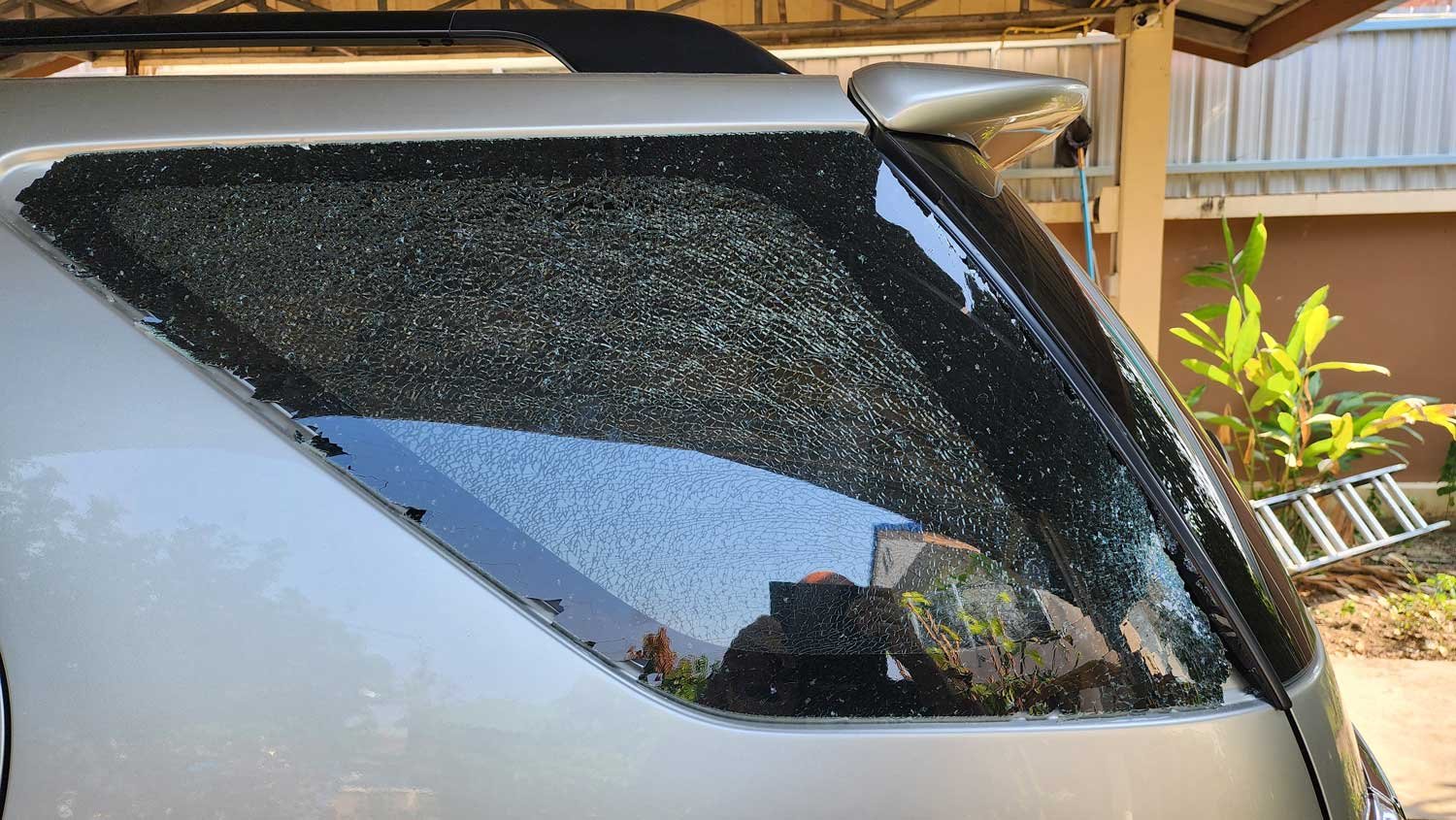
-
 1
1
-
-
32 minutes ago, Crossy said:
Yes... Local handyman did the repair for a couple of beers. No way could l do it with a cast on my leg. Apart from that, my better half has banned me from going up there until l get a walkway put up there.
-
 1
1
-
-
- Popular Post
- Popular Post
<Crossy> posts split from the Solar Doghouse thread as off-topic but posted here to serve as a timely warning.
A serious word of caution. Those fabricated cement can be fragile. So extreme care is required when working on the panels, as I found out recently to my cost.
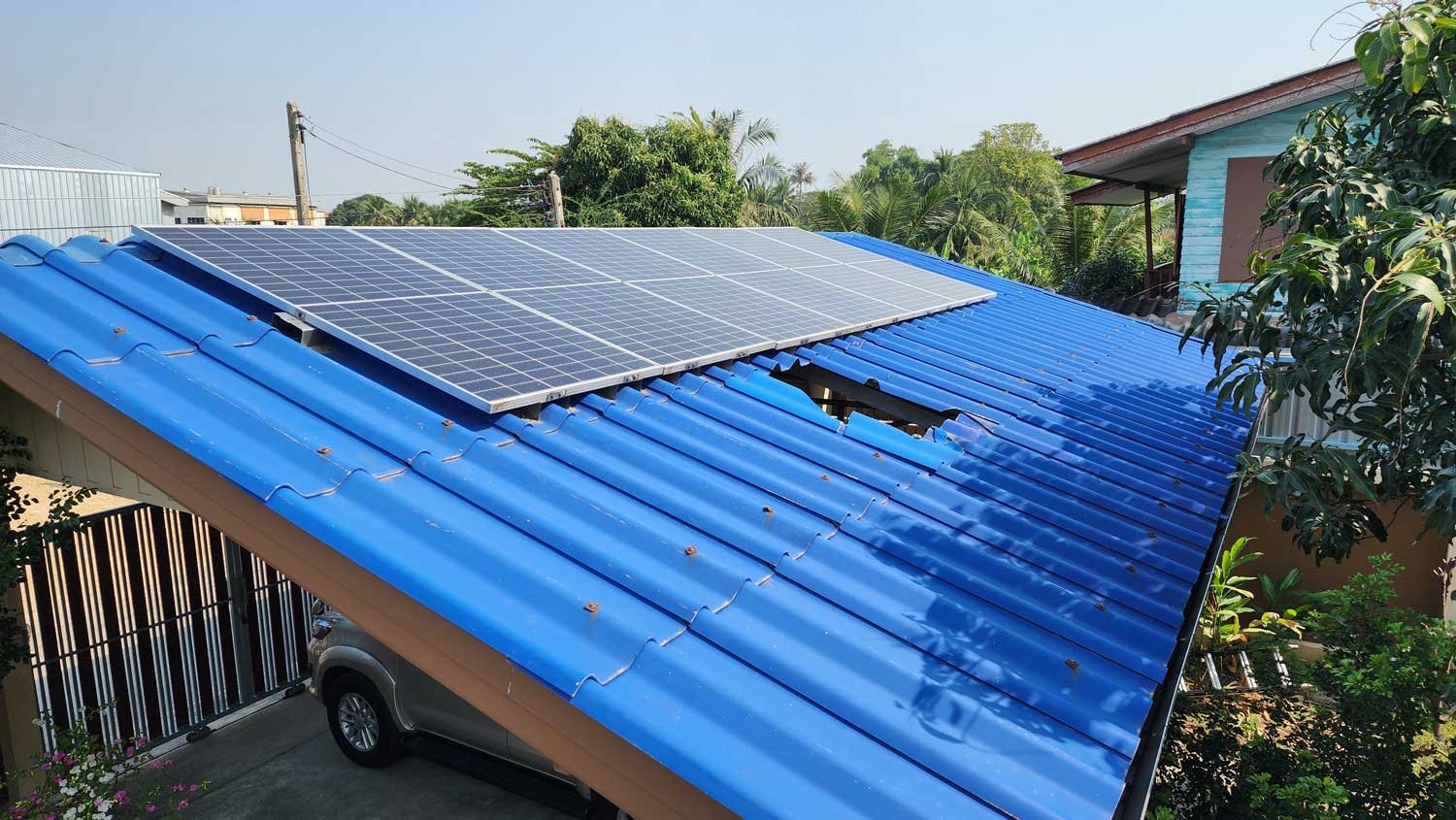
In my case it was 3 plus meters from roof to floor. Gravity can take over in a split second and its not the fall that hurts, it’s the sudden stop at the bottom. Concrete is very unforgiving.
Result was, 5 fractured ribs, collapsed lung, fractured ankle, 16 stitches in various cuts, 2 nights in ICU and a further 2 on a general ward and a massive hospital bill. All good fun. On a good note: the upgrade is working as anticipated and producing sufficient power to meet our needs during daylight hours.
Good luck with your project.
-
 3
3
-
 1
1
-
 1
1
-
7 hours ago, SAFETY FIRST said:
Gawd, dead from a leg injury. 🤔
7 hours ago, bkk6060 said:Sure. It's called the Femoral artery bleed out in 3 to 5 minutes.
6 hours ago, simon43 said:Agreed, but if so, why isn't the photo awash with blood?
For your information:
The femur (the large bone in the upper leg (between the pelvis and knee) if fractured (broken) can damage major blood vessels within the upper leg, such as the femoral artery which carried blood from the heart to the lower limb, or the femoral vein which carried blood from the lower limb back towards the heart.
If either of these major blood vessels are damaged, they can bleed profusely inside the upper leg, often with little or no outward signs of blood. If the bleeding is not controlled very quickly, the amount of blood within the circulatory system rapidly decreases. This in turn causes the heart to try and pump faster to ensure that there is a sufficient blood supply to the vital organs (brain, liver, kidneys etc). As more blood is lost, it quickly becomes a ‘vicious circle’, the heart will try to beat faster and faster to compensate for the increasing blood loss.
Unfortunately, the heart can only beat so fast for a relatively short period of time before it goes into cardiac arrest (stops working). If the bleeding is not controlled, and CPR administered quickly, brain cells will be irreversible damaged, and death will occur.
In the case of a bullet wound (depending upon the size of the bullet), the entry wound is often relatively small, with minimal external bleeding. The real damage is done when the bullet hits the bone and the bullet and often the bone fragment. It is these fragments that then damage the major blood vessels (femoral artery and vein) and rapid bleeding then occurs inside the leg and is only noticeable by the rapid swelling of the thigh.
Regrettably, Thai rescue personnel are, in the main, only trained in very basic first aid procedure (scope and run) and not equipped to undertake advanced life support procedures which would be needed in this case.
-
 1
1
-
 1
1
-
-
Upgrade Update
Up at the crack of dawn yesterday morning to turn off the inverter and the system’s AC and DC breakers before starting work to connect the two new panels to the existing panels on the carport roof.
I managed to complete the connection and securing the panels onto their mounts before the sun became to strong to continue working on the carport roof.
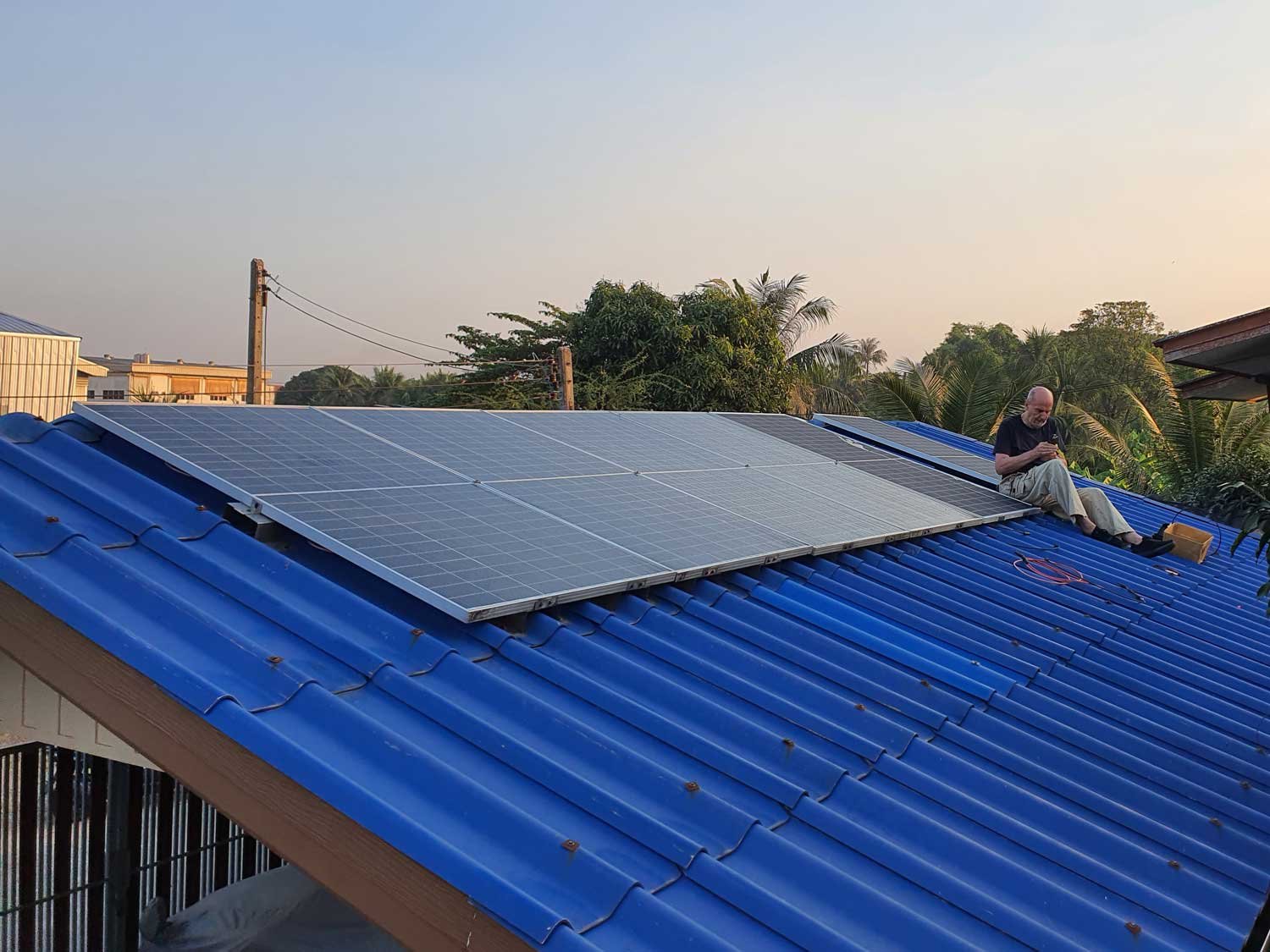
Back on terra firma, I did a quick check to ensure that the input polarity to the DC breaker was correct before switching everything back on. Thankfully the needle on the AVO meter swung in the correct direction and showed a reading of 240V (DC), which with the 6 panels, and moderate sunlight, was about what I was expecting.
With fingers crossed, I turned on both of the system breakers and then switched the inverter on. The inverter went into its start up check sequence and a few moments later the system showed “Normal operation”. Fortunately no ‘flash bang’ or ‘magic smoke’ thank goodness.
A quick look at meter on the pole outside the house showed that it was merrily spinning backwards at a ‘rapid rate of knots’. Upon checking the system’s monitoring facility (on my PC), the system showed a marked increase in power produced (e.g. about 40% plus) when compared against the same time the day before.
After a full day of operation the system monitoring facility shows about 45% increase in production, as can be seen from the graphs blow. Given that there were a few intermittent clouds shading the sun during the day, the increase power production was as I was expecting.
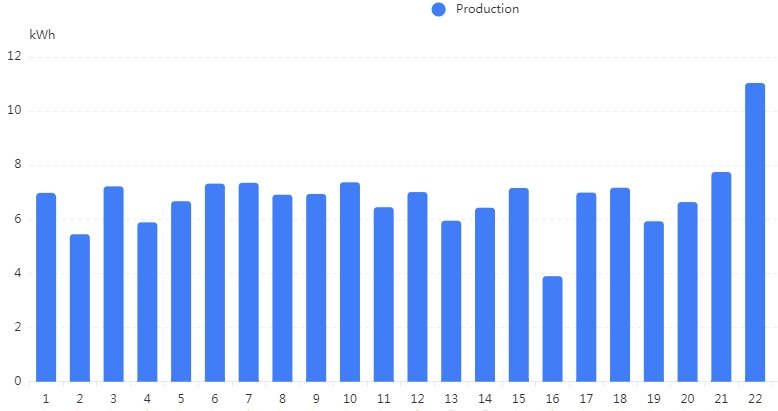
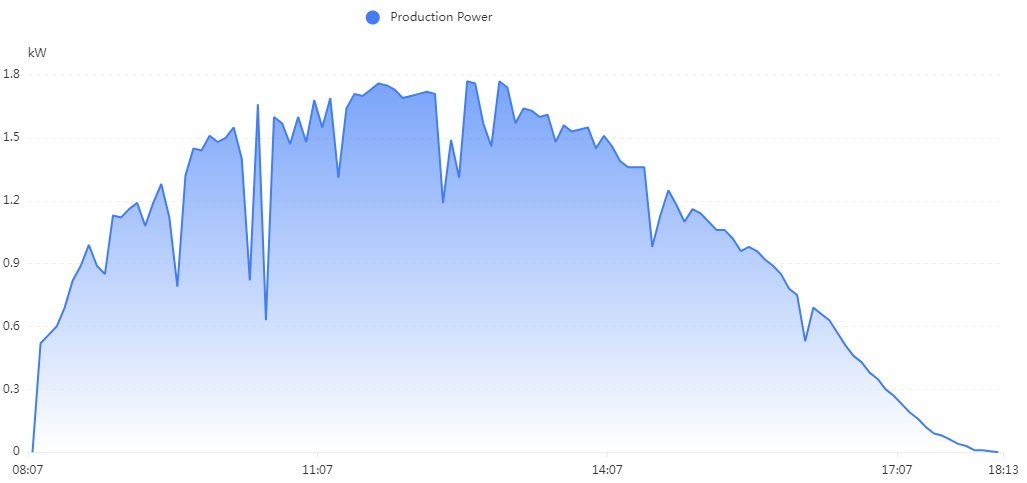
So now having spent an additional 8,000 THB on the 2 extra panel, I hope that they quickly repay my moderate investment.
The only problem that I envisage is that with the added potential production there is a risk that my small scale system may well start pushing the spinning meter into negative territory, so this is something that I will need to monitor in the coming weeks as I certainly don't want the
 when the meter reader comes next month.
when the meter reader comes next month.
All good fun.

-
 1
1
-
 1
1
-
-
- Popular Post
- Popular Post
UPDATE - ROI After 2.25 Years
Well, as predicted in my original post (above), my small scale grid tied system has really earnt its money over the past 2.25 years. The system was a DIY install with the hardware costing 28,000THB (give or take a few THB).
According to the systems monitoring facility (as of this morning), the system has produced a grand total of 6,670 units, which at 4.2THB/unit (the total cost per unit on the day the system was activated), has resulted in a saving of 28,020THB on our electricity bills, as per screen shot below.
I appreciate that this is relatively small compared to the ‘big boys’, but it has proved a really worthwhile investment. Each unit the system produces from now on is ‘profit’
 .
.
In my original post I mentioned that the day may well come when the local PEA come and replace our lovely spinning disc meter with a shinny new electronic one. Ironically, since I posted that remark, my better half received 2 phone calls from people purporting to be from the PEA and advising her that they (PEA) were coming the following day to install a digital meter. On both occasions nobody from the PEA turned up and we still have our spinning disc meter. It turned out that these were scam calls trying to get my wife to disclose her bank details on the pretext that they (PEA) would transfer a refund for the original meter into her account. Thankfully she never disclosed any details to the callers.
As a result of those 2 calls, and the need to turn the system into NO EXPORT mode for a week (or so) after each call as a ‘safety’ precaution, I decided that I would upgrade my system by installing an additional 2 x 415W panels. This upgrade would hopefully mean that even with the NO EXPORT mode activated, the system should be able to still meet approximately 75% of our day time needs without feeding back to the grid if required.
Luckily, I managed to get the additional panels from my original supplier (wow, still trading after 2 plus years). Same make, with free delivery, and only a small increase in the costs of the panels.
The biggest task was getting the panels up onto the carport roof. Unfortunately, this time there was no large crane available to lift them up there (for a moderate backhander). It was shear man power, and a good deal of determination, but they are in place and they'll be connected tomorrow before sun rise, with everything being turned off to start with.

So looking forward to seeing a potential 50% increase in output tomorrow, with no 'magic smoke', fingers crossed. All good fun.
-
 1
1
-
 2
2
-
 4
4
-
 1
1



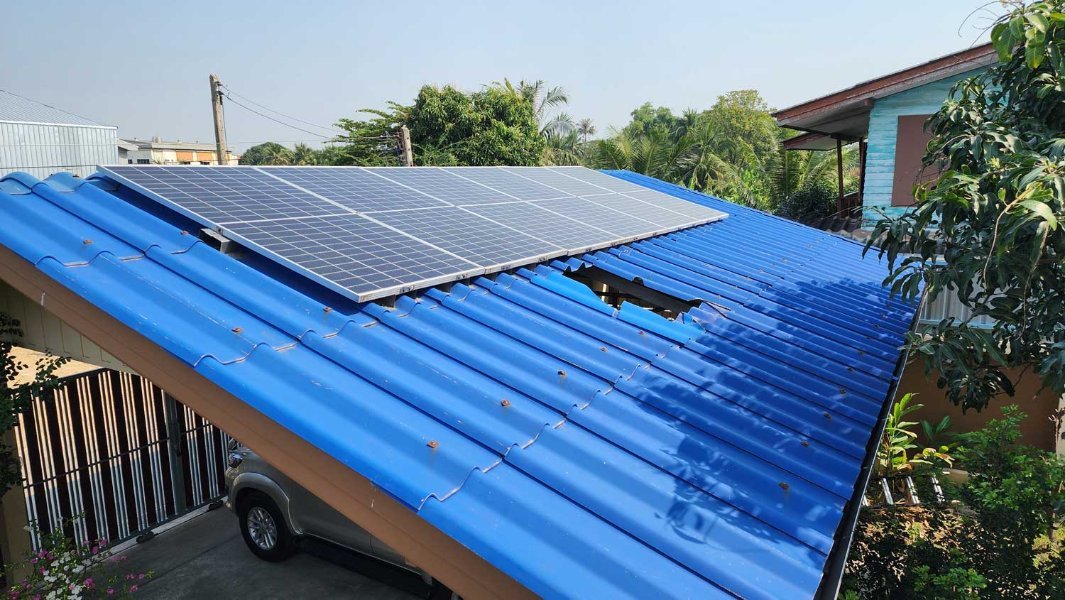
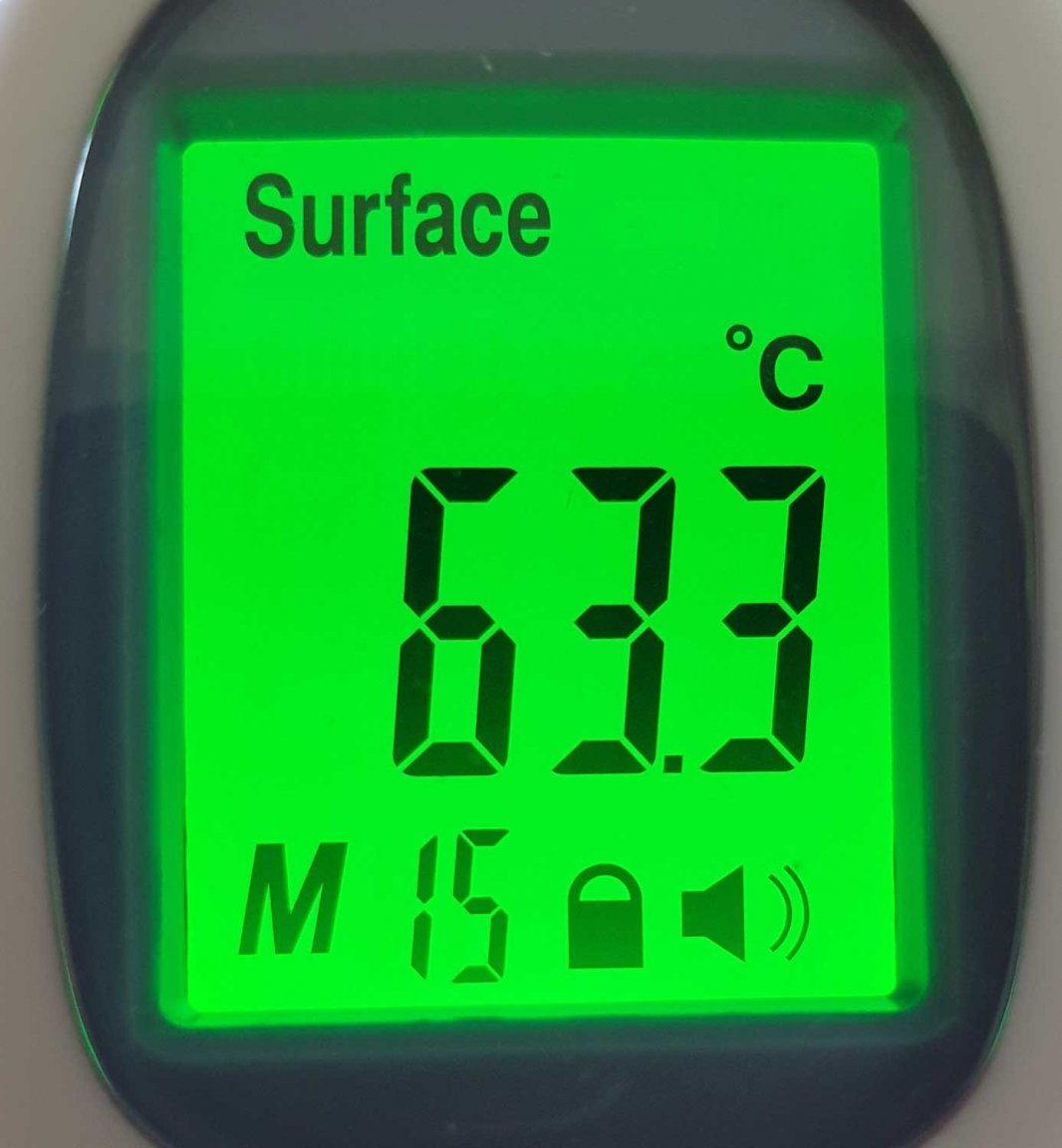
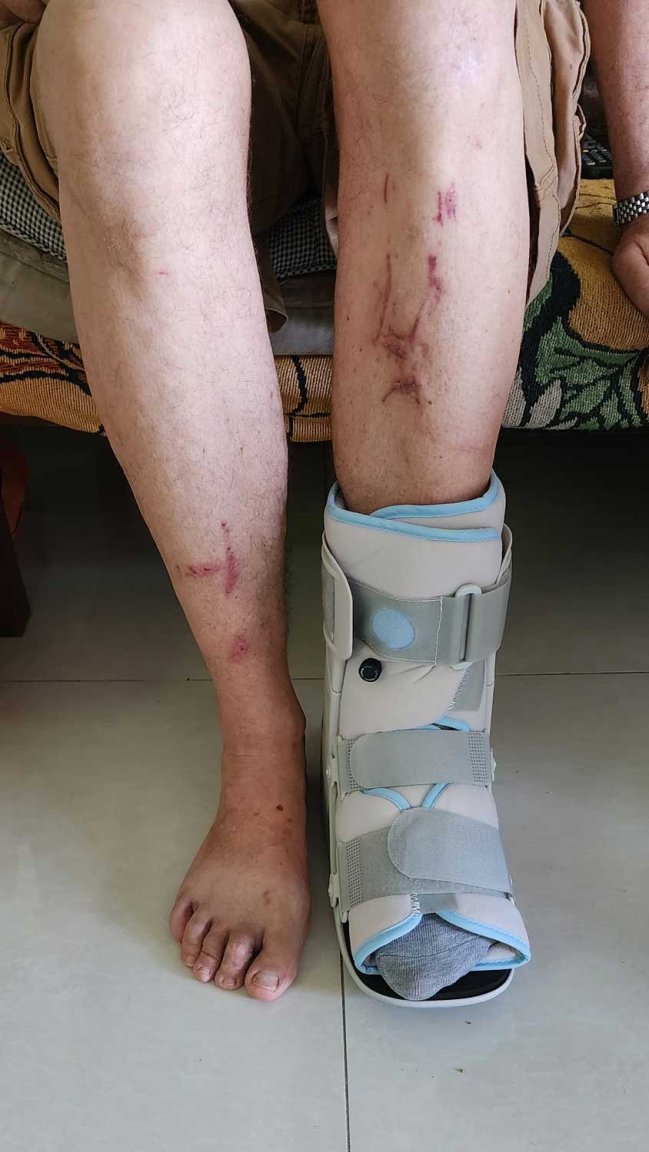
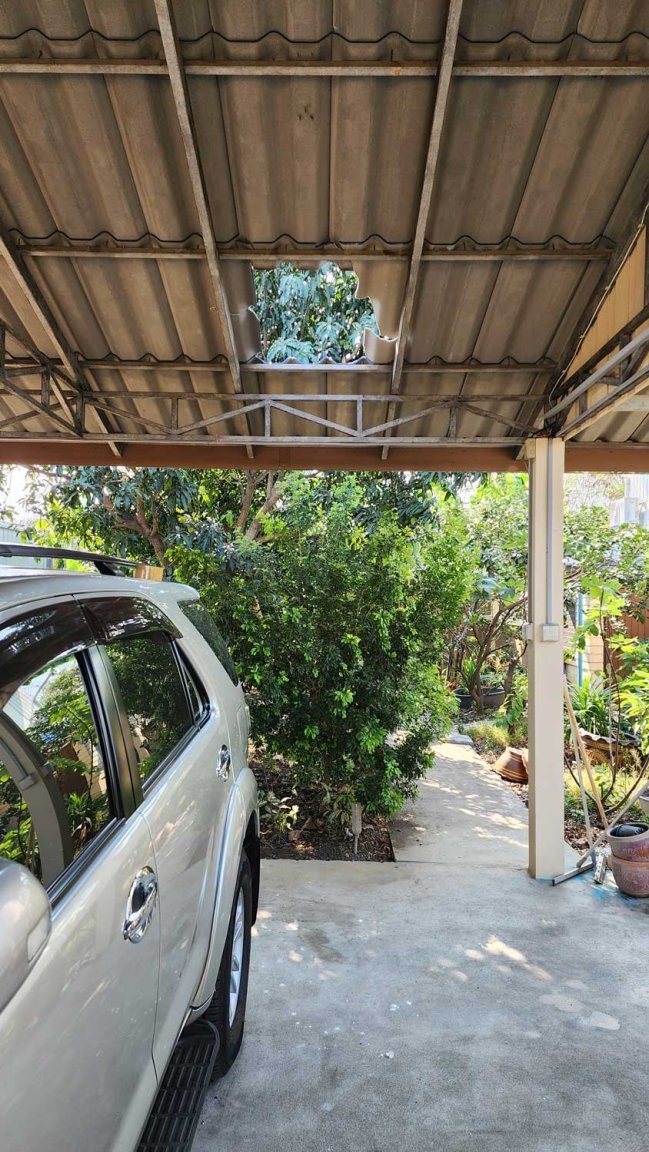
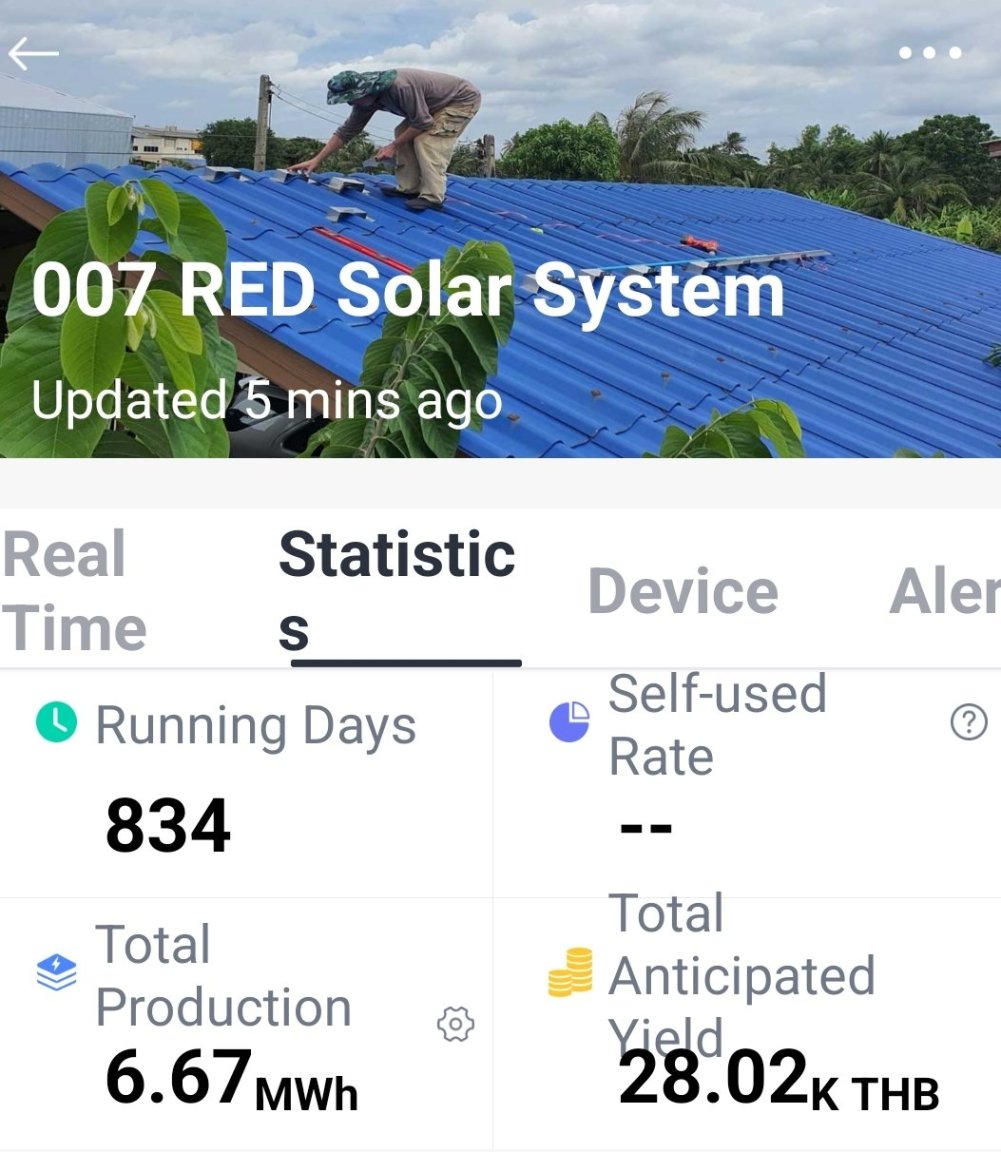
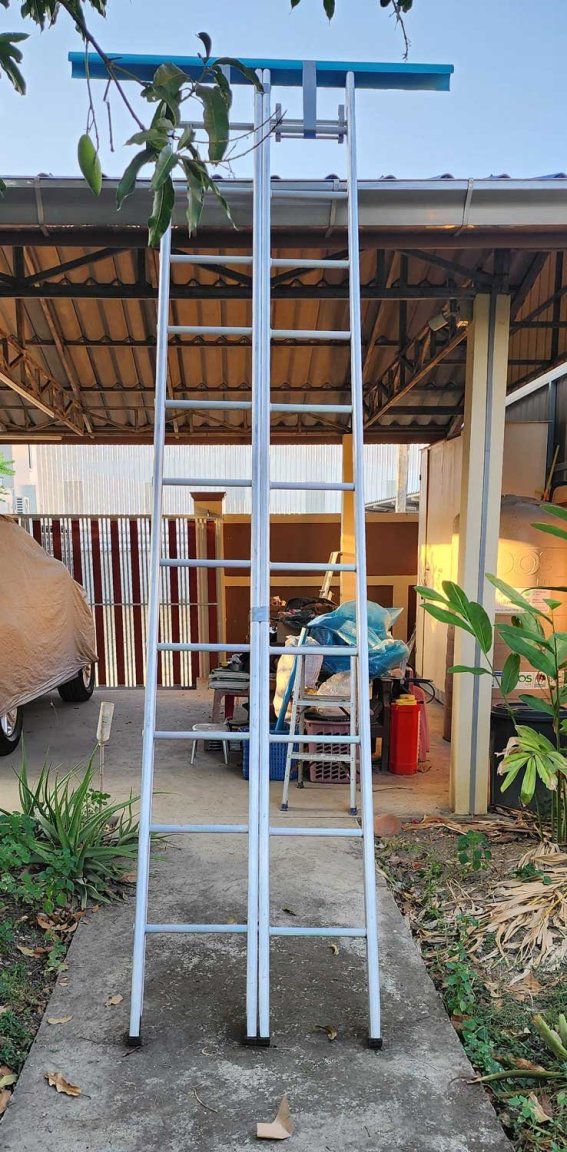
New Thai Cabinet Finalised: PM Paetongtarn Takes Culture Minister Role
in Thailand News
Posted
A very crafty move, appointing herself as Culture Minister. Why ?
Because if the Constitutional Court decides that there is a case to answer regarding her phone call to Hun Sen, and they decide to temporarily remove her as PM, she can still cling onto her post in the cabinet.